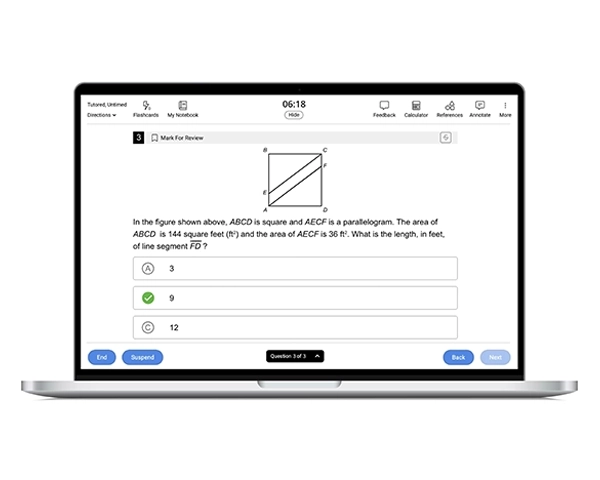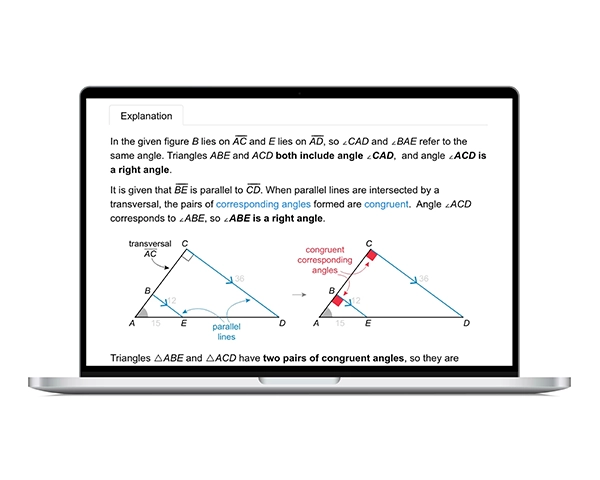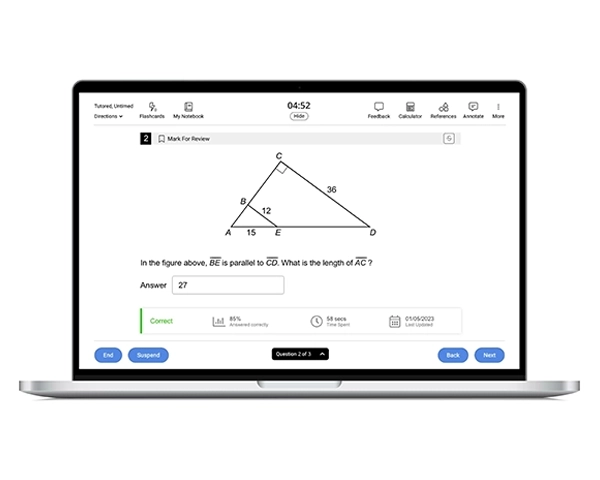How to Study for Digital SAT® Math
Study Plan & Exam Tips
The Digital SAT® math section accounts for half your total score. So, high performance is essential to getting your dream score. In this guide, we will explore the factors you'll need to consider to ensure you reach that score. Scroll through the following sections for general Digital SAT math tips and strategies, what Digital SAT math review materials to emphasize, and how to shape your own Digital SAT math review guide or study plan.
How to Study for Digital SAT Math
The Digital SAT math section covers content1 from Algebra through Advanced Math, Geometry and Trigonometry, and Problem-Solving and Analysis, so regardless of your grade level or current math course, you're likely to find new content that requires comprehensive study, old content on which you need a refresher or both. Even students who feel confident in all the tested subject areas should familiarize themselves with the format and timing of the exam if they hope to receive a high score.
All Digital SAT studies begin with a full-length, timed, and scored practice test. This diagnostic will shape your overall plan by revealing how close you are to your goal, where your content gaps lie, and how comfortable you are with the test format.
Once you've taken a diagnostic test, consider how much time you can devote to studying. If unsure, most effective study plans incorporate 3-5 hours of study a week for at least three months. Regardless of how long you have, be sure to keep up with practice tests every couple of weeks to verify your progress and measure the effectiveness of your current strategies.
Your diagnostic tests should shape the content of that study by revealing your strengths and weaknesses. Group the questions you need clarification on as you study into subcategories. Practice with a subcategory at a time. It will speed up your progress in that area and help you identify patterns or strategies that apply to multiple question types.

How to pass the Digital SAT Math section
Universities and the College Board® do not deem any Digital SAT score as "passing" since the exam is not graded on a pass/fail basis. That said, be sure to look up the score range most commonly accepted by any school or competitive major to which you plan to apply and use those to determine your target score.
If your diagnostic test score is far from that target, you likely need to fill in some content gaps. Group the questions you answered correctly and incorrectly from your practice test into categories based on the four official SAT math domains Algebra, Problem-Solving and Data Analysis, Advanced Math, and Geometry and Trigonometry. (The UWorld performance dashboard automatically does this for you.)
Prioritize your Digital SAT math study by focusing on the categories in which you made the most mistakes first, then do content refreshers on the material you got right. If your performance is less than satisfactory in all four sections, practicing by category will help you focus your attention so you can find patterns or tips that apply in that content area.
How do I do well on Digital SAT Math?
High performance in the Digital SAT math section requires familiarity with the content, the exam format, and how to tackle both under pressure.
- The most valuable resource for improving both is practice tests. Full-length, timed tests expose you to the format and structure of the exam, and the breadth of content on any given practice test is sufficient to introduce you to each of the four Digital SAT math domains.
- Improve your math skills, one subject at a time. If you're missing most of the Algebra questions (which comprise ⅓ of the section) on any given practice test, practice your algebra skills before moving on to Problem Solving and Data Analysis, the Advanced Math, or Geometry and Trigonometry areas.
- Take notes on the methods and formulas each question requires. As you come across particular solutions for a math category that you find challenging, take time to memorize those strategies and their component formulas.
- On average, the Digital SAT gives you a little more than a minute per question. If you find that many question types take more than that minute or even a few questions take more than 90 seconds to answer, consider a new approach to those questions during your practice. Come at similar questions from different angles or rework the same question with alternate methods until you find a strategy to solve similar problems more quickly and confidently.
How to approach SAT Math questions
At the broadest level, remember that the Digital SAT aims to verify your skill in and understanding of various math concepts. As you’re approaching any given question, consider the math course material that it could be testing and what mistakes are common to that material. For example, if a question refers to a quadratic equation, consider whether it’s testing your awareness of a given method of solving quadratic equations (factoring, completing the square, the quadratic formula) or of given qualities to that equation’s graph (number of solutions, vertex, direction) and how to find them.
At a more minute level, approach each question with care and diligence, underlining information, drawing or annotating figures whenever possible, and writing down your process in a way that will allow you to verify its correctness even after you’ve moved on to other questions.
Tips to get 800 on Digital SAT Math
While challenging, any student can make an 800 Digital SAT math score feasible through sufficient and effective practice. As you build your study plan, consider the following four strategies for how to get 800 on Digital SAT math:
- Building up to 800 requires a starting point. Begin by taking a practice test to establish your baseline performance so you know where you stand before you begin your journey.
- Take notes both during and after practice and on the exam itself. Annotations help clarify your thinking, identify essential information and potential traps, plus allow you to understand where you went wrong on questions you've missed. Note-taking after practice helps you synthesize what you've learned and better incorporate it into application on future questions.
- Practice a lot2. While an 800 doesn't always require a perfect score, correctly answering every
Digital SAT math question on a given exam is the best guarantee of a perfect score. The best way to do so is to
answer similar questions in practice many times before correctly.
- Achieving your dream score on at least two full practice tests before sitting for your actual exam serves as the clearest indicator of the likelihood of your success.
- Remember that the Digital SAT is a test. Every Digital SAT question assesses your skill or knowledge in a particular content area. If you can quickly identify the Digital SAT math category to which any given question belongs, you are more likely to spot the traps, miscalculations, and misconceptions the test writers have incorporated into the wrong answer choices.
How long should you study for Digital SAT Math?
The length of your study plan is dependent on the difference between your dream score and the score you’re currently earning on practice tests. Most students should expect to spend at least three months in preparation for the Digital SAT; doing so provides ample opportunity for multiple practice tests and time to study and practice concepts and question types in isolation. Consider creating a condensed study plan if your diagnostic score meets your satisfaction to keep your skills fresh or an extended plan if your practice score falls more than 200 points below your target.
How do you develop an independent study or self-study plan for Digital SAT Math?
Like the SAT, the Digital SAT math section covers content from Pre-Algebra through Geometry, Algebra II, and Pre-Calculus, which means you'll need to recall specific concepts from multiple classes. Chances are you took these classes over a few years, and you already learned how to solve these problems, so you need to refresh your memory on how to solve these problems and practice answering them in under a minute. Enter Digital SAT math independent study.
A full-length, timed, and scored practice test is the first step in any self-study plan. This diagnostic will help you shape your overall strategy: the score will reveal how close you are to your goal, where your content gaps lie, and how comfortable you are with the test format. This information, in turn, will dictate how long you should practice and what material you should review during that independent study session.
Once you've taken a diagnostic test, consider how long you can devote to studying in any given week. Standard study plans incorporate 3-5 hours of study a week for at least three months, but your diagnostic score and academic schedule may demand more or less of you than that. Regardless of how long you have, punctuate your SAT study plan with practice tests every 2-3 weeks to verify your progress and measure the effectiveness of your current strategies.

Digital SAT Math Exam Study Tips
Regardless of how far in advance you can study, make the most of your time by following the tips below.
Take High-Quality Practice Tests
The best way to ensure you're ready to get the score you need is to earn that score on a Digital SAT practice test. Diagnostic tests should be used not only as you begin studying but also throughout your SAT math study plan, as they reveal progress, identify weak areas, and help you get a better feel for the format and timing of the exam.
While the College Board offers a few practice tests, taking one every few weeks during your study plan is essential. Generate an unlimited amount of Digital SAT math practice tests using the questions in the UWorld QBank, then explore the comprehensive explanations, which add to the value already inherent in the practice by immediately filling in the conceptual gaps identified by the diagnostic.
Underline key parts of the question
While you may feel confident that certain portions of a math question are obvious or that you'll remember them, underlining as you read the question helps to cut down on re-reading time. It keeps you focused on only the most relevant information, limiting mistakes. For example, when faced with a simple equation, your first instinct may be to solve for x even when the question asks for (x + 1).
As a rule of thumb, underline any values and their identifiers (the information indicating what the number represents) and the final portion of the question showing what variable you're solving.
Be aware of your time
The Digital SAT allows you slightly more than a minute per question on average. Timing yourself on any given question can help you identify growth opportunities. There is likely a faster method or solution for any question that takes you more than a minute to answer. Reassess such questions and look for another approach. Quality explanations like those in the UWorld QBank will help you quickly understand how to solve problems independently. If the questions you're working with are paired with no or limited explanations, work with a friend, teacher, or tutor to devise an effective approach.
Eliminate 3 wrong answers
While incorporating the process of elimination (POE) may seem like an obvious Digital SAT math tip, it is crucial to consider how and when to apply this strategy.
By noting what each choice's unique values suggest about the context, you can quickly solve questions with answer choices that are all variations on the same structure (such as different equations written in slope-intercept form). For example, in our slope-intercept case, ask what a different slope or constant would suggest about a situation's starting value or rate of increase.
Others are more subtle. When faced with a question regarding a realistic context, consider what each value in the answer choices would represent in that specific context. For example, people and objects can only be represented by whole numbers (you can’t have 0.24 humans). Any choice suggesting otherwise can be eliminated right away. Similarly, eliminate choices whose values are far too high or low for the context (a car traveling at 60 mph is reasonable; one traveling at 280 mph is not).
Additionally, POE is a useful strategy for verifying your answers. If you can identify three answer choices with incorrect values, you can be certain that the remaining choice is correct. For this reason, consider including POE when reviewing material or taking notes, even on questions you can answer without it; doing so will help you to recognize the traps and miscalculations the test writers build into the wrong answer choices.
Make sure your calculator is in good working condition
Though the Digital SAT includes a built-in DESMOS calculator, on the test day students are permitted to use their own calculators3. Double-check that your calculator works properly before test day and is considered an approved calculator. Check out the approved calculators list on our Digital SAT® Test Policies page. Remember that you might be banned from using your own calculator if you carry a calculator not approved by the College Board.
Translate words into math
You can model almost every Digital SAT math question with an equation or expression. Help yourself recognize how to solve the question by restructuring the context into an equation whenever possible. For example, if a context describes a profit dependent on the number of items sold, note the profit on one side of the equal sign and the relevant costs on the other. Or, if you're asked the final price of an item after multiple percentage-based discounts, write out the original value and multiply it by the percent's decimal value.
Draw diagrams or label theirs
If a Digital SAT question refers to an image, most of your work should revolve around that image. If one is provided, wonderful: label it with the values included in the question. If not, no problem: draw your own, including those labels as you go. Visualizing the problem will limit mistakes by ensuring your work is verifiable and revealing connections between values you would have otherwise missed.
Learn some mental math tricks
While all Digital SAT math questions allow the use of a calculator, learning and applying mental math techniques can enhance your speed and accuracy, providing valuable alternatives to calculator reliance. As you follow your Digital SAT math study plan, try approaching all questions with and without a calculator until you’ve learned which strategy works best for particular question types. For instance, the Digital SAT favors fractions over decimals. Although some calculators can provide answers in both forms, decimals are typically the default output. Therefore, learning to divide and simplify fractions mentally or manually will enable you to reach the expected answer more efficiently on the exam.
Digital SAT Math Section Review/Study Materials
Besides diagnostic tests, the most important resource for your math preparation is an abundance of Digital SAT-like math questions paired with comprehensive, easy-to-follow (and apply) explanations. As you shop for study materials, prioritize those with a heavier emphasis on practice questions (those whose questions look and feel like real Digital SAT questions). For example, UWorld's Digital SAT math question bank is modeled to mirror the format and key concepts tested by the Digital SAT, plus comes with illustrated, step-by-step breakdowns of each answer that teach not only that question's solution but also strategies for approaching similar questions on exam day.
Key Takeaways
Practice is the core component of Digital SAT math preparation. Taking practice tests effectively mimics the actual exam experience and serves as a yardstick for measuring progress toward achieving your desired score. Completing practice questions also ensures alignment between your in-class studies and the specific content covered in the exam, keeping your preparation practical. Maintaining practice notes helps organize your progress and performance into actionable, easily memorized strategies.

References
1(2024). What’s on the digital SAT Math test?. About the digital SAT Math test. Khan Academy
Retrieved February 12, 2024, from
https://www.khanacademy.org/test-prep/v2-sat-math/x0fcc98a58ba3bea7:about-the-digital-sat/x0fcc98a58ba3bea7:what-is-the-new-digital-sat/a/about-the-digital-sat-math-test.
2(2024). How should I use this course? About the digital SAT Math test. Khan Academy Retrieved
February 12, 2024 from
https://www.khanacademy.org/test-prep/v2-sat-math/x0fcc98a58ba3bea7:about-the-digital-sat/x0fcc98a58ba3bea7:what-is-the-new-digital-sat/a/about-the-digital-sat-math-test.
3(2024). SAT Calculator Use. SAT Suite of Assessments. College Board Retrieved February 12, 2024
from
https://satsuite.collegeboard.org/sat/whats-on-the-test/math/calculator-use.